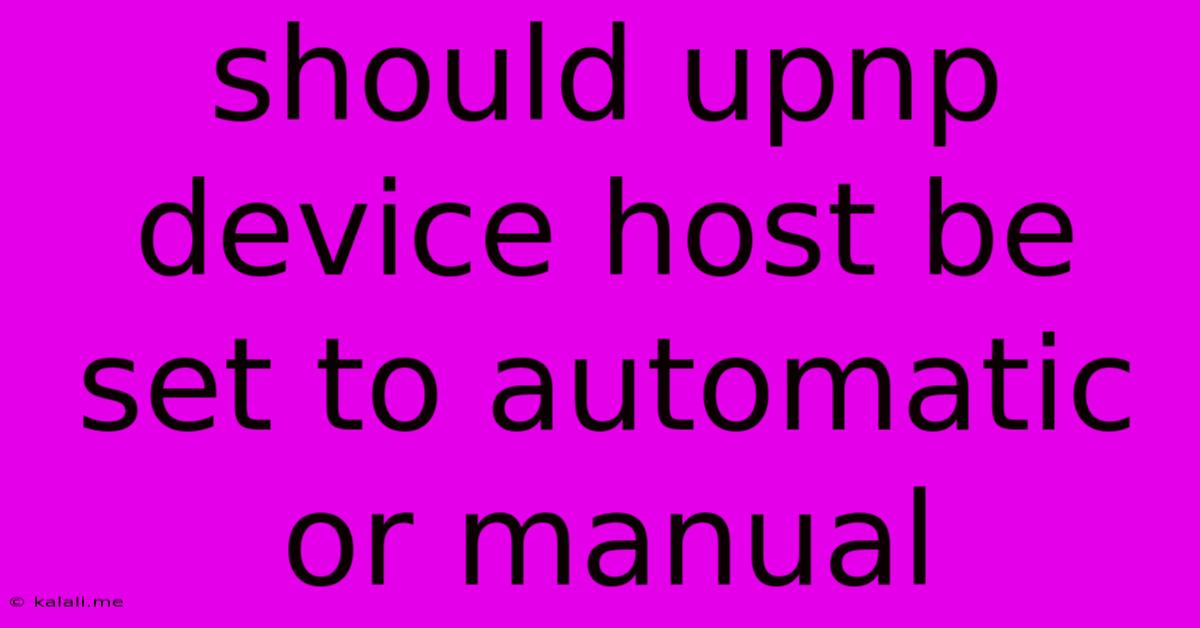Should Upnp Device Host Be Set To Automatic Or Manual
Kalali
May 23, 2025 · 4 min read

Table of Contents
Should UPnP Device Host be Set to Automatic or Manual? A Comprehensive Guide
Meta Description: This guide explores the pros and cons of setting your UPnP device host to automatic or manual, helping you decide the best option for your network security and convenience. Learn about UPnP vulnerabilities and how to mitigate them.
UPnP, or Universal Plug and Play, is a networking technology that allows devices to automatically configure themselves on a network. While convenient, it also presents security risks. The question of whether to set your UPnP device host to automatic or manual is a crucial one for network security and overall system stability. This article will delve into the intricacies of this setting, helping you make an informed decision based on your specific needs and risk tolerance.
Understanding UPnP and its Functionality
UPnP simplifies network configuration by allowing devices to automatically discover and connect to each other. This eliminates the need for manual port forwarding, making it easier to set up things like gaming consoles, printers, and media streaming devices. Essentially, when set to automatic, your router automatically opens ports necessary for these devices to function correctly.
Automatic UPnP: Convenience vs. Security Risks
Setting your UPnP device host to automatic offers significant convenience. It's a simple, one-click solution that eliminates the need for technical expertise in configuring network ports. However, this convenience comes at a cost:
- Security Vulnerabilities: Automatically opening ports increases your network's vulnerability to external attacks. Malicious actors could potentially exploit these open ports to gain unauthorized access to your network and devices. This is particularly concerning if you have sensitive data stored on your network.
- Uncontrolled Access: You have less control over which devices access your network and the resources they can utilize. This lack of visibility can lead to performance issues or unexpected behavior.
- Potential Conflicts: Multiple devices might attempt to use the same ports, leading to conflicts and malfunctions.
Manual UPnP: Increased Security and Control
Choosing manual configuration means you will manually forward ports for each device requiring access. This approach provides:
- Enhanced Security: Manual port forwarding gives you granular control over which ports are open and which devices have access. This significantly reduces the attack surface of your network.
- Improved Network Visibility: You have a clear understanding of which devices are using which ports, facilitating troubleshooting and identifying potential issues.
- Better Resource Management: Manual configuration allows for optimized resource allocation, preventing conflicts and improving overall network performance.
However, manual configuration demands technical expertise and time. You must understand networking concepts like IP addresses and port numbers, which might be daunting for less technically inclined users.
Choosing the Right Setting: Factors to Consider
The optimal setting depends heavily on your network's needs and your level of technical expertise. Consider these factors:
- Your Network Security Needs: If you handle sensitive data or regularly deal with online threats, prioritizing security with manual configuration is strongly recommended.
- Your Technical Skills: If you're comfortable configuring ports manually, then manual configuration provides better control and security.
- The Number of Devices: If you only have a few devices, manual configuration is manageable. However, with many devices, automatic configuration might be more practical, though riskier.
- Your Router's Security Features: Some routers offer advanced security features that mitigate the risks associated with automatic UPnP. Explore your router's settings to see what options are available.
Best Practices Regardless of Your Choice
Regardless of whether you choose automatic or manual UPnP, these best practices will improve your network's overall security:
- Keep your router firmware updated: Regular updates patch security vulnerabilities.
- Use strong passwords: Protect your network with complex and unique passwords.
- Enable a firewall: A firewall acts as an extra layer of protection against unauthorized access.
- Regularly review your network's devices and their configurations: This helps identify any unauthorized or suspicious activity.
Conclusion: A Balanced Approach
The choice between automatic and manual UPnP is a trade-off between convenience and security. While automatic UPnP offers ease of use, it poses higher security risks. Manual configuration, although more demanding, provides better control and protection. Weigh these factors carefully to determine the best setting for your specific circumstances. Prioritizing security, especially for networks handling sensitive information, generally makes manual configuration the more responsible option.
Latest Posts
Latest Posts
-
What Does Pinche Mean In Spanish
May 23, 2025
-
Is It Easy To Switch From Aikido To Judo
May 23, 2025
-
Cement Adhesive Coming Out From Railing
May 23, 2025
-
How To Replace A Toilet Seat
May 23, 2025
-
Skyrim Where To Find Fortify Speech Enchantment
May 23, 2025
Related Post
Thank you for visiting our website which covers about Should Upnp Device Host Be Set To Automatic Or Manual . We hope the information provided has been useful to you. Feel free to contact us if you have any questions or need further assistance. See you next time and don't miss to bookmark.